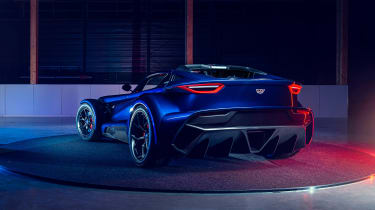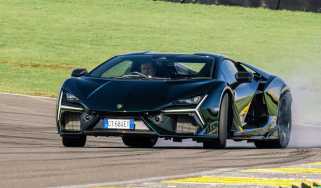Donkervoort F22 production run extended (again) to 100 units
The 667bhp/ton F22 has proven more popular than anticipated, with Donkervoort expanding the production run once more
In a world of four-figure power outputs, two-tonne kerb weights and seven figure price tags, Dutch sports car manufacturer Donkervoort has created a much needed tonic for 2023 called the F22: a 750kg, 500bhp two-seater sports car priced from €245,000 plus taxes. Due to high demand, the firm has increased production from 75 units to 100 in total, with first cars already with buyers around the globe.
Replacing the D8 GTO, Donkervoort’s new F22 is a nut and bolt update of its predecessor with not a single carry over part in the car’s tubular-steel carbon-clad chassis. While it retains Donkervoort’s distinctive coupe-convertible design, the F22 is longer, wider and taller than the car it replaces (a result of its homologation for North America and the Middle East), but it’s only 55kg heavier at 750kg. This low weight gain is down to the use of carbonfibre for as many of the body panels – including the removable roof panels – as possible.
> 429bhp Donkervoort D8 GTO Individual Series revealed
Powering that 750kg is Audi Sport’s 2.5-litre five-cylinder turbocharged engine as found in today’s RS3 and TT RS, with 492bhp and 472lb ft of torque, up considerably on the 394bhp and 369lb ft produced by the same engine when used by Audi. A larger turbocharger and a 10.1:1 compression ratio accounts for the bulk of the increases, along with the myriad of updates not least to the ECU. It means the F22 boasts a formidable 667bhp-per-ton power-to-weight ratio.
Drive remains to the rear wheels only, via a TKX five-speed manual gearbox, which saves around 12kg over a six or seven-speed unit, that’s mated to a Torsen limited slip differential. The diff no longer requires an additional oil cooler due to a new housing that’s stronger, lighter and quietens the diff, too. Bosch’s match rev technology is also fitted, although this can be switched off and the five speed’s throw is as short as practicably possible.
Underpinning the chassis is a set of TracTive adaptive dampers controllable from the cockpit rather than having to get on your hands and knees, this includes the 35mm of ride height adjustment also possible. The front suspension is independent double-wishbones, the rear adopting the same layout but with the addition of trailing arms. Brakes are by AP, with four-piston calipers front and rear with 330mm front discs, 279mm rear, with 8x18-inch front wheels paired with 10x19s on the rear fitted with Nankang’s AR1 tyre (235/40 and 275/35 respectively) tuned accordingly to Donkervoort’s specification.
Performance is hypercar level quick, with 62mph arriving in 2.5-seconds and 120mph in 7.5, with a 180mph maximum for the brave. As it’s a car designed for the track, but still road legal, it only registers 79db static.
Initially only 50 F22s were to be built, but these sold when Donkervoort released some early design sketches. As a result, an additional 25 cars were added to the total, before the marque added 25 more in March 2023 bringing the total to 100. Production began in January 2023, with finals cars now set to roll out of the factory in 2025.







